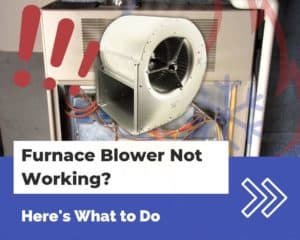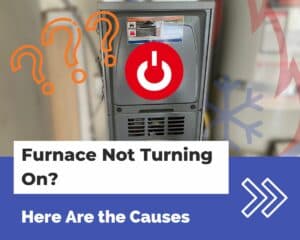Your furnace has been giving you some trouble, so you take a look at it and discover that it’s covered in water. So what now?
Leaking water is a common issue in high-efficiency furnaces and furnaces with cooling coils. In most cases, a furnace that’s leaking water can be fixed by cleaning a few parts.
Here are some possible causes of a furnace water leak:
- Clogged condensation drain line
- Clogged condensate trap
- A leak from the whole-house humidifier
- A leak from the secondary heat exchanger
In this article, I’ll go over how to fix all the different types of furnace water leaks. I’ll also help you identify the source of the leak so you can fix it fast!
How to fix a furnace condensation leak
To fix your furnace’s water leak, the first thing you’ll need to do is find the source of the leak.
Different types of leaks will show up in different places in your furnace.
For example, if your humidifier is leaking water from the inside, then it’s likely due to the condensate drain line or drain trap inside the furnace.
Here is a guide on how to address different types of leaks in your furnace:
- What to do when your furnace is leaking water from the condensate pipe
- What to do when your furnace is leaking water from the top
- What to do when your furnace is leaking water from the humidifier
- What to do when the inside of your furnace is leaking water
What to do when your furnace is leaking water from the condensate pipe
A clogged drain line will cause your condensate pipe to leak water all over your furnace.
But where does that water come from?
- If you have a high-efficiency furnace, the water is coming from the combustion gases.
- If it’s cooling season and you are using your AC, then the condensate is coming from the cooling coil.
So how do you fix a leaky condensate pipe?
Start by finding a way to disconnect the condensate drain pipe.
On one side of the drain pan, the drain outlet is connected to the drain pipe.
The drain pipe is usually made of PVC or flexible vinyl tubing. If your drain pipe is made of flexible tubing, then you’re in luck—you can easily remove it from the drain outlet and clean everything out.
If your drain pipe is made of PVC, you’ll need to take the pipe and fittings apart.
Don’t worry about having to cut the PVC—the pipes are usually put together without glue. You can pull the pipes apart and put them back together.
Once the drain pipe is removed from the drain outlet, it’s time to clean out the drain pipe.
Check out my article below for instructions on how to unclog your furnace’s drain pipe:
Furnace condensate drain pipe corrosion
Another possible cause of a leaky furnace condensate drain pipe is corrosion.
Condensate from high-efficiency furnaces is acidic, so it will corrode metal and copper pipes.
If you have a high-efficiency furnace with metal or copper drain pipes, then you should use a neutralizer to keep the acidity of the condensate in check.
In fact, most municipalities require you to use a neutralizer for your furnace condensate.
The efficiency of furnace condensate neutralizers diminishes with time, so it’s crucial to replace them to maintain their effectiveness.
If you have PVC pipes, then you won’t need to worry about the condensate corroding your furnace’s drain pipes. But you still might be required to use a neutralizer if the municipality’s piping is metal.
What to do when your furnace is leaking water from the top
If your furnace is leaking water from the top, your first step is to find the leak. Water doesn’t just magically appear on the top of furnaces, so you’ll need to figure out exactly where the water is coming from:
- If it’s heating season, water on the top of your furnace is likely coming from your whole-house humidifier.
- If it’s cooling season, water on the top of your furnace is likely coming from your AC coil or condensate drain.
Both whole-house humidifiers and AC coils are usually positioned above the furnace. So if your humidifier or AC condensate drain starts leaking, then water is likely to trickle down onto the top of your furnace.
The next section details what you should do when your furnace is leaking water from its humidifier.
I also have an article that goes over what you should do if your AC condensate drain line is clogged.
What to do when your furnace is leaking water from the humidifier
If your furnace is leaking water from its whole-house humidifier, you’ll need to remove the clog to stop the leak.
Your first task is to figure out where the leak is coming from.
The leak in your whole-house humidifier is likely coming from one of these places:
- The humidifier pad is degraded and clogging up the humidifier, causing water to leak out.
- The humidifier drain pipe is clogged up, causing water to leak out.
In either case, you’ll need to take apart the humidifier and clean it out. Cleaning out a whole-house humidifier is a simple process that involves turning off your furnace, opening up the humidifier, and scrubbing out its insides.
If you are going to clean out your whole-house humidifier, you might as well replace its humidifier pad at the same time. Old degraded humidifier pads are one of the most common causes of a leaky whole-house humidifier.
Check out this video from Michigan Heating Guy that details the repair of a leaking whole-house humidifier:
What to do when the inside of your furnace is leaking water
If you have a high-efficiency furnace that’s getting wet on the inside, then you likely have a leak from the condensate trap or drain.
But why does my furnace have a condensate drain? I thought those were only for ACs?
It’s true that ACs have condensate drains. But some furnaces have them too!
High-efficiency furnaces need a condensate drain to drain out the moisture they produce.
Why do high-efficiency furnaces produce condensate?
High-efficiency furnaces use a second heat exchanger to heat your home’s air more efficiently.
The second heat exchanger pulls extra heat out of a furnace’s exhaust gases.
When the second heat exchanger removes heat from the exhaust gases, the water vapor in the exhaust gases condenses into liquid form. The liquid condensate drains out of the furnace through the condensate drain line.
In fact, high-efficiency furnaces are also called condensing furnaces since they produce condensate.
Some high-efficiency furnaces have a drain line and condensate trap inside of the furnace. The built-in drain line is responsible for removing condensate from the secondary heat exchanger out of the unit.
If you have water leaking inside of your furnace, the most likely source is the condensate drain line or trap.
The condensate drain line is a plastic pipe inside your furnace. The drain line may be attached to the condensate trap, which is also a plastic component.
Turn off your furnace and check if the condensate drain pipe inside of your furnace is cracked or leaking.
Also check if the condensate trap is cracked or leaking.
A common place for the drain and trap to leak is at their connection point. So make sure that the condensate drain and trap are connected securely together.
What to do when your secondary heat exchanger is leaking water
Another possible cause of water leaking inside your furnace is a cracked secondary heat exchanger.
The secondary heat exchanger is where condensate forms inside your high-efficiency furnace.
If the secondary heat exchanger is cracked, then condensate will leak into your furnace.
Although its rare, a cracked secondary heat exchanger is a serious problem. If your secondary heat exchanger is cracked, you’ll need to get it replaced.
Unfortunately, replacing a heat exchanger isn’t something that you can do yourself, so you’ll need to hire a local HVAC professional to replace it for you.




Hi Trey. My problem is water [acidic water] that has burned through the copper pipe I was using to connect to the drain about 12 feet away. My nephew who is 900 miles away and works in HVAC says I need to replace the neutralizer that loses its effectiveness over the years. My furnace is a Luxaire Acclimate Series 9T. Model no. is FL9T060B12UP11B. Any help would be appreciated. Thanks
Hi Lorne,
Yeah, you should replace the neutralizer to ensure that the acidity of the furnace condensate is kept in check. Otherwise the acidic furnace condensate will corrode your pipes.
-Trey
Is there a condensate neutralizer already in my furnace and/or do I just add a neutralizer to the plastic hose where the water exits the furnace?